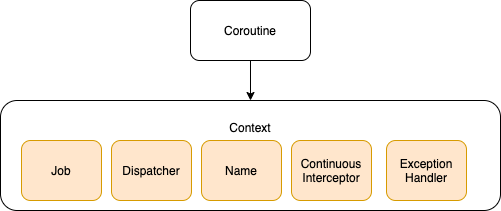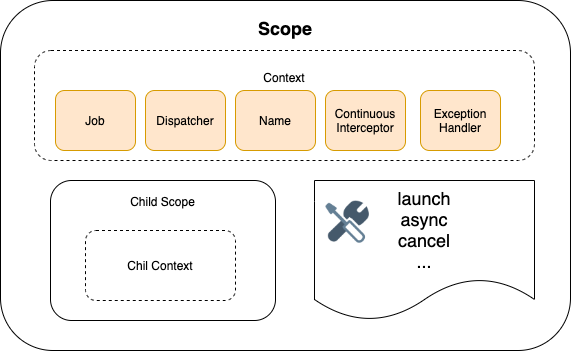Coroutine Scope vs Coroutine Context
CoroutineContext
Coroutines always execute in some context represented by a value of the CoroutineContext type, defined in the Kotlin standard library.
/**
* Persistent context for the coroutine.
* It is an indexed set of [Element] instances.
* An indexed set is a mix between a set and a map.
* Every element in this set has a unique [Key].
*/
@SinceKotlin("1.3")
public interface CoroutineContext
CoroutineContext is just a Map that stores a set of Element objects that have a unique Key.

An Element is anything a coroutine might need to run correctly. The most common examples would be:
Job- a cancellable handle to a coroutine with a lifecycle;CoroutineDispatcher,MainCoroutineDispatcher- dispatchers for a coroutine to run on;CoroutineId,CoroutineName- elements mainly used to debug coroutines;CoroutineExceptionHandler- an element that handles uncaught exceptions;Continuation Interceptor- allows one to define how coroutines should continue.
CoroutineScope
A CoroutineScope is just a simple wrapper for a CoroutineContext. In a technical sense, it is nothing more than a CoroutineContext, and the only reason it exists and has a different name is to differentiate the intended purpose of the two.
public interface CoroutineScope {
public val coroutineContext: CoroutineContext
}
CoroutineScope performs the following functions:
- Provides an abstraction for manipulate contexts and jobs, help us to manage them;
CoroutineScopealso keeps track of all its children’s scopes. e.g. when perform alaunchwithin another scope, a child scope is created automatically;- It provides all the utilities to
launch,async, and alsocanceletc…; - Enforce structured concurrency.

Links
Coroutine context and dispatchers
Things every Kotlin Developer should know about Coroutines. Part 1: CoroutineContext
Things every Kotlin Developer should know about Coroutines. Part 2: CoroutineScope
Kotlin Coroutine Scope, Context, and Job made simple
 Kotlin - no_image
Kotlin - no_image